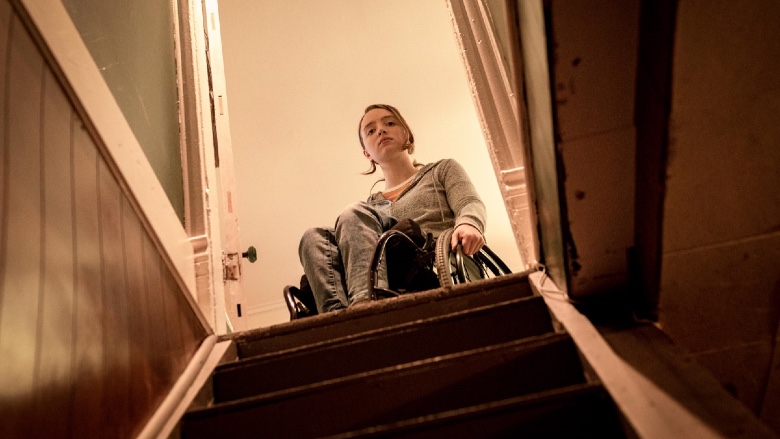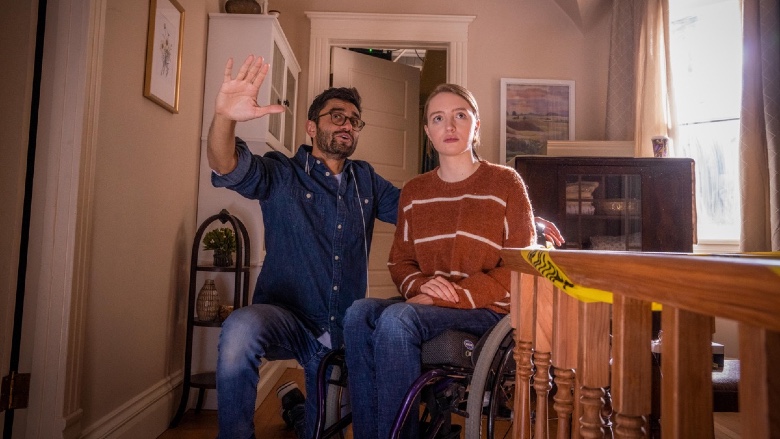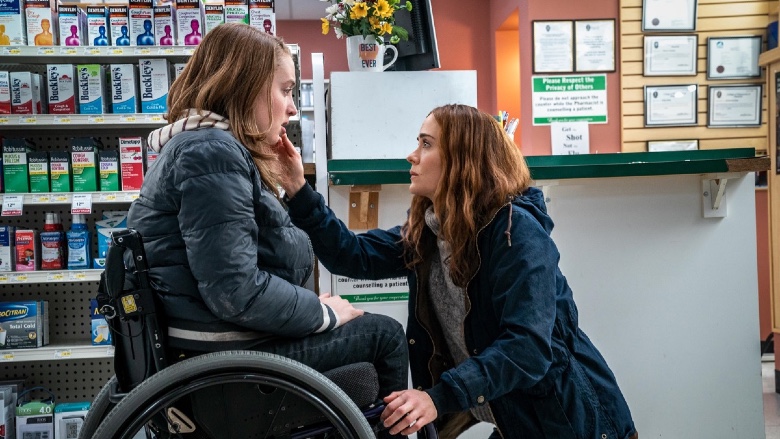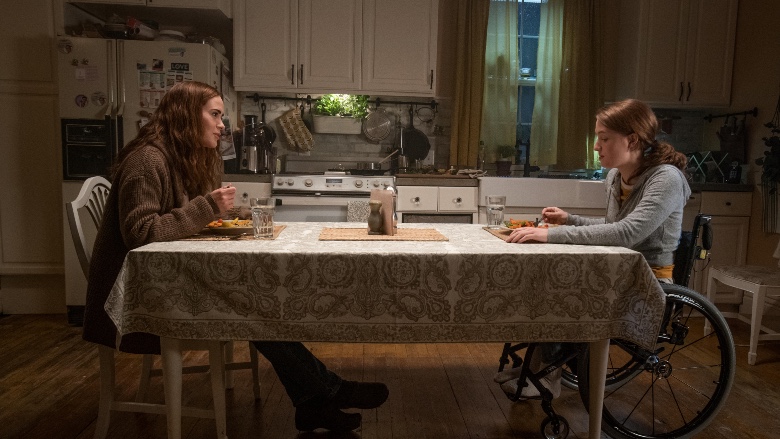
When Aneesh Chaganty’s debut feature Searching premiered at the Sundance Film Festival in 2018, it immediately showed a bright new talent to the world of cinematic thrillers.
Chaganty’s new movie Run is a two-handed thriller starring Emmy winner Sarah Paulson and newcomer Kiera Allen as an overprotective mother and her daughter Chloe, the latter who has been waylaid by a number of debilitating illnesses since birth. One day, Chloe is given a new medication which seems odd and when she starts looking into it, she starts to realize that her mother may be hiding a secret or two, one in which she’ll do anything to keep Chloe from even leaving the house in fear she’ll find out the truth.
Below the Line got on Zoom with Chaganty to talk about working with his creative team to build up some of the tension found in Run.
Below the Line: Was the script for Run something you had in your back pocket already when Searching debuted at Sundance? Or was it something you came up with after that movie was received so well?
Aneesh Chaganty: During the entire process of making Searching, which is such a technically complex — it’s a gimmick that we made work, but it’s a gimmick, nonetheless — a crazily unconventional film. I think all I wanted to do during that whole process was the opposite, which is something very simple, bare bones classic, and honestly, timeless. For as much of a 2018-2019 movie Searching is, with the exception of one scene that takes place on a computer for 30 seconds in this movie, [Run] could be set in the 70s, it could be in the 80s, it could be in the 90s. It has this anytime, anywhere place to it on purpose. I think to me, personally, I wanted to just prove to myself that number one, do you want to be placed in a box and number two, prove to myself that I actually knew how to make a movie outside of these traditional confines. Run is very much a response to Searching, for better or for worse, it’s a direct response. All of those qualities to making it the most bare bones version of itself was to rebel against Searching. Moving forward, I think I’ll probably find a balance between the two, but this was just, “Let’s do the opposite, and let’s do it now” kind of deal before we got into this box.
BTL: I’m glad you got away from the computer screen device, because I’m not sure I could watch another movie like that on my laptop right now. When you went into this, what were some of the things you wanted to bring into it creatively to make it different from other thrillers?
Chaganty: There’s two things that our intention was to try and sort of separate it. Number one is on the page. I think what makes this contained home thriller, different than other contained home thrillers is the fact that our lead looks a lot different than all the other leads in these contain thrillers. This time, the doorknob is a challenge. An elevator can be a challenge, a pencil can be a challenge, a notebook can be a challenge. What we wanted to do with this film was basically, by putting our lead character uses a wheelchair in the movie — and in real life, but in the movie specifically — can we turn everyday objects? Can we turn this house from this idyllic image that’s presented at the beginning of the film where everything’s kind of rosy and perfect into much more of a prison? Could that prison be 10 times 20 times worse if our character uses a wheelchair? Can we turn that into a significantly harder puzzle for her to solve, and have it only be solved based on her own ingenuity, using these MacGyver tech tools, her hands and her brain power, could she outsmart these very mundane but very impossible to beat physical challenges? That’s on one scale and then create a challenge, for me at least, making this to anybody else would be a significantly simpler experience. To me, it was my first live action film, so there was a lot of learning on my end where I was like, “Okay, how does that work? Okay, I’m not allowed to touch the camera, a lot of learning on that end. I think on a creative level, this film was always intended to feel like a Hitchcock movie or Shyamalan movie in the way that it’s composed, in the way that it feels and hopefully, how little it cuts and whatnot. Every single frame of this movie was storyboarded and hand-drawn by me. You could do a one-to-sone comparison of how every single thing is exactly matching. I didn’t want to cut that much. I wanted to stay very composed, so from the beginning, I was trying to recreate these images from the top and really try and invoke the sort of masters that I grew up watching, all within the confines of hopefully a very sort of interesting, home escape kind of film.

BTL: You answered one of my questions because the young actor who plays Chloe is amazing, and I wasn’t sure if she was wheelchair-bound normally
Chaganty: From the beginning, after having made Searching, for Sev [Ohanian, co-writer] and I, it was just no-brainer as far as like, if we’re writing a character in a wheelchair, we gotta find an actor that uses a wheelchair. Moving forward, that will be one of these things. There’s no reason to not be able to slide a cool card in a deck, moving forward on these movies. That is just objectively the right move for us. The only thing that was really hard about it was it involves more resources to go off and find this person, because this person, theoretically, doesn’t have an agent, they might not have a manager, they might not know that they could act. How do you find that person? It involved this massive casting hunt led by our Casting Director, Rich Delia, we were putting posters up in after-school programs, disability programs, art programs, Facebook. Everyone was talking to each other, and we were getting in hundreds and hundreds of tapes from people, all from the disabled community, all artists. I was just watching all these tapes being flabbergasted by how big of an umbrella a lower body disability is, which was the the exact framing of our casting notice. I was watching these tapes, and Kiera just pops up, and all of a sudden, it didn’t feel like acting. I felt she was just saying something, but it was the lines we wrote. I gave her some notes on it, she performed again, we flew her out to LA and then from there, we were just watching a star be born. Of all the things that this movie does right, that’s the thing it does right and does well the most, which is take somebody who… I don’t know. Maybe her talent would have blown up at one point, but give this persona shot. She’ll always now have our movie in parentheses to market her and get someone else to buy into her as well.
BTL: She is also acting against Sarah Paulson who is no slouch when it comes to acting, so you really threw her into the deep end for her acting debut.
Chaganty: In one way, it’s the scariest thing. In another way, you could argue that you HAVE to act with Sara. You’re gonna perform, because she is gonna MAKE you perform. There were times where I was watching Sarah’s performance, where I thought that if I were in front of this take, you’d probably get the first good performance that I could ever give. She’s so in the take, her character just demands your involvement. It’s so interesting, and such a unique skill set that Sarah Paulson has. I think she is truly one of our top three working actors today just by how good she is. It’s almost object of anybody watching her, how good she is. What better acting school could you have for a young actor than to just learn from the best and talk to the best all the time? The way I worked with her and specifically the combination with the way that she worked with Sarah, and vice versa, I think we put Kiera in a very good position, and then her raw talent took us over the edge.

BTL: I want to ask about working with your DP Hillary Spera, who did not work on your previous movie. How did you find her and pick her to film Run?
Chaganty: Obviously, moving from Searching to Run, the demands of it from a visual standpoint are pretty different. Hillary was somebody who [Producer] Natalie Qasabian had worked with in the past. I met a bunch of DPs throughout the process of interviewing. They all had the script, and they all came in with mood boards and talking about how they saw it. Hillary just read the script and pitched me the movie that I knew in my head, to the level where she was citing the same shots, the same people, the same filmmakers, talking about which lens and what she wanted to shoot it on, and how she would evoke that look from that one movie that was definitely a reference. It immediately became this shorthand with us and the best part about it was by the end of it …. in the storyboarding process that I was alluding to earlier, I was talking about every frame that I drew out, the first person that I’ve go to these frames with always was Hilary. Two doors down in our production office, I’d walk down and sit down with her for an hour and pitch these new storyboard scenes. She would immediately be able to tell you, “That doesn’t feel Hitchcock, that doesn’t feel right,” and we’d cancel them. On the set, when you’re naturally forced to improvise, I’m physically not going to be able to just stay with the camera all the time. There’s literally 1900 things happening at once when you’re making a movie, at least for me. How do I trust her to improvise? There was no question about that. I knew that the direction that she was giving her team was to always make the movie feel what we were going for. Whatever people think about the movie, I think from a visual standpoint and from an editing standpoint, it does accomplish a lot of those original goals that we set out. Now that we have that shorthand, I don’t have an intention to work without her.
BTL: You also had Torin Borrowdale, who previously scored Searching, doing the music again, and for this one, you could lean into Hitchcock a little more. I was surprised by how music was in there really low creating a bed throughout the movie but then it really got more apparent until the second half. Can you talk about working with him again?
Chaganty: Thanks for asking about Torin. Torin and I have been partners in a way since we’re both in college – we went to USC together. He was doing music or the shitty short films I was making with good music, and that relationship kept us going through. When we made Run, there was no question we were going to work together. Using Hitchcock as a reference, the music to this movie really had its own process of its own. Originally, we thought the film was going to be entirely composed of sounds that you could only make with your hand, because that’s what Chloe is good at, rhythmic stuff and things like that. Over the course of the film, as we started to purify what it was, it started to be like this should sound a Hitchcock movie. This should sound like what Signs did, when you’re using the same James Newton Howard score. It’s like [sings a few notes]. If you listen to that soundtrack, every single track on it is those same three notes. It’s just the way it’s played, changes the tone. I was like, “We’re doing that for Run. We’re making it as simple as the story is.” The Run soundtrack is just those four notes [sings four notes slowly and then quickly]. That level of understanding, it was it’s own process to understand how Hitchcock it should be common and how simplified it should become. He’s a really, really good collaborator, and I’m really glad to have made another movie with this kid.

BTL: I also want to talk about the editing. After watching the movie, I watched the trailer again, and maybe half the stuff in the trailer isn’t in the movie. I was curious if this was a longer movie before or was there just stuff that they put in the trailer that didn’t end up in the movie?
Chaganty: I’ll answer that question but I’m answering the question with a border around the garden I’m in. In making any movie, you shoot the script, then you shoot the movie, then you do the edit, and whatever is best at every point is what’s going to happen. For me, the biggestdifference between what the version of this movie that without anybody’s oversight or anything that would have been versus what it is now is I think [there’s] a lot more investment into the mom and daughter relationship in the first half of the movie. What you’re talking about and seeing in the trailers are the dining table scenes and the emotional scenes. Those all happened in the first half of the film, and it’ll all be in the deleted scenes on the Hulu thing I’ll introduce. I think the whole movie was originally intended to be a family drama meets this thriller. I think what ended up coming out of it was a thriller. For better or for worse, and it’s up to our viewers to decide, there was a lot more emphasis on that family drama part early on. For example, when Chloe finds the pill… in the original version when Chloe finds the pill and that evening tells her mom, and she thinks that her mom is sick with something or she’s not telling her, and Chloe asks if she’s a burden of some sort. That’s just constantly building that relationship. On the flip side, you could argue that we never needed any of that. You can say that their performances and their takes were so good that you just got their relationship without anything else that we needed to say.
Run hits Hulu on Friday, November 20. Check back next week for a special “Making the Scene” piece on one specific scene in Chaganty’s thriller.





